MDS software stack install instructions for Windows¶
Important
This guide has been (lightly) adapted from the UBC-Vancouver MDS Install stack under a CC-BY-SA 4.0 license.
These instructions will walk you through installing the required Data Science software stack for the UBC Master of Data Science program. Before starting, ensure that your laptop meets our program requirements:
runs one of the following operating systems: macOS 10.15.X (Catalina), Ubuntu 20.04, Windows 10 Professional, Enterprise or Education; version 2004.
Windows 10 Home is not sufficient as not all the software required for the program can be installed on that OS. Click here to download Windows 10 Education for free from UBC.
When installing Ubuntu, checking the box “Install third party…” will (among other things) install proprietary drivers, which can be helpful for wifi and graphics cards.
can connect to networks via a wireless connection
has at least 50 GB disk space available
has at least 8 GB of RAM
uses a 64-bit CPU
is at most 6 years old at the start of the program (4 years old or newer is recommended)
uses English as the default language
Students’ whose laptops do not meet the requirements specified above will not be able to receive technical assistance from the MDS team in troubleshooting installation issues.
Table of Contents¶
Installation notes¶
If you have already installed Git, Latex, Make, or any of the R or Python related packages please uninstall these and follow the instructions below to reinstall them (make sure to also remove any user configuration files and backup them if desired). In order to be able to support you effectively and minimize setup issues and software conflicts, we require all students to install the software stack the same way.
In all the sections below, if you are presented with the choice to download either a 64-bit (also called x64) or a 32-bit (also called x86) version of the application always choose the 64-bit version.
Once you have completed these installation instructions, make sure to follow the post-installation notes at the end to check that all software is setup correctly.
UBC Student Email¶
Please sign up for a UBC Student Email. This account will also grant you access to a range of UBC services, including Microsoft Teams and OneDrive. To do so navigate to https://it.ubc.ca/services/email-voice-internet/ubc-student-email-service and follow the instructions under “Get Started”.
Web browser¶
In MDS we will be using many tools that work most reliably on Google Chrome and Firefox (including our online quiz software), so we recommend that you use one of these browsers.
To install Chrome, go to https://www.google.com/chrome/, click on “Download Chrome” and follow the instructions on the website to finish the installation.
To install Firefox, go to https://www.mozilla.org/en-US/firefox/new/, click on “Download Firefox” and follow the instructions on the website to finish the installation.
LastPass password manager¶
Some MDS courses (e.g. the capstone project) use the LastPass password manager to share credentials. Although we will not cover privacy and security topics until the second semester of the program, we recommend that you use a password manager such as LastPass to help you create strong passwords and store them securely, and to facilitate online authentication. You can sign up for a free LastPass account here: https://lastpass.com/create-account.php. We also recommend installing the LastPass Chrome or Firefox browser extension available here: https://lastpass.com/misc_download2.php.
Slack¶
For MDS program announcements, course forums, and correspondence we use the communication tool Slack. Slack can be accessed via the web browser, but we recommend using the Slack app, which can be installed via downloadable file from the slack website https://slack.com/intl/en-ca/downloads/windows.
Visual Studio Code¶
The open-source text editor Visual Studio Code (VS Code) is both a powerful text editor and a full-blown Python IDE, which we will use for more complex analysis. Go to https://code.visualstudio.com/download and download the windows version of VS Code. After the download has finished, run the installer and accept the default configuration for all pages except for the following:
Optional On the Select Additional Tasks page, check “Create a desktop icon” under “Additional icons”.
Also on the Select Additional Tasks page check all four boxes under “Other”
“Add ‘Open with Code’ action to Windows file context menu”
“Add ‘Open with Code’ action to Windows directory context menu”
“Register Code as an editor for supported file types”
“Add to PATH” (this should be selected by default).
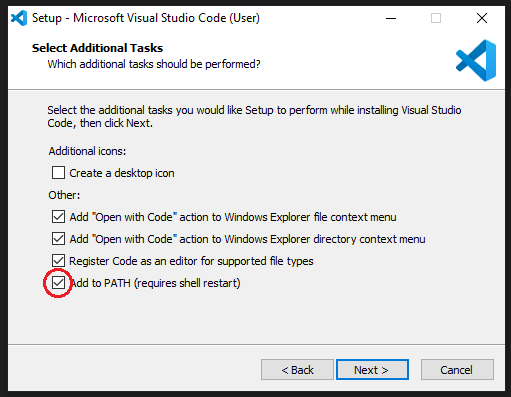
GitHub.com¶
In MDS we will use the publicly available GitHub.com. Please follow the set-up instructions for both below.
Sign up for a free account at GitHub.com if you don’t have one already.
Git and Bash¶
Although Git and Bash are two separate programs, we are including them in the same section here since they are packaged together in the same installer on Windows. Briefly, we will be using the Bash shell to interact with our computers via a command line interface, and Git to keep a version history of our files and upload to/download from to GitHub. We will be using the command line version of Git as well as Git through RStudio and JupyterLab. Some of the Git commands we will use are only available since Git 2.23, so if you’re Git is older than this version, we ask you to update it.
Go to https://git-scm.com/download/win and download the windows version of git. After the download has finished, run the installer and accept the default configuration for all pages except for the following:
Optional On the Select Components page, check “On the Desktop” under “Additional icons”.
On the Choosing the default editor used by Git page, select “Use Visual Studio Code as Git’s default editor” from the drop-down menu’
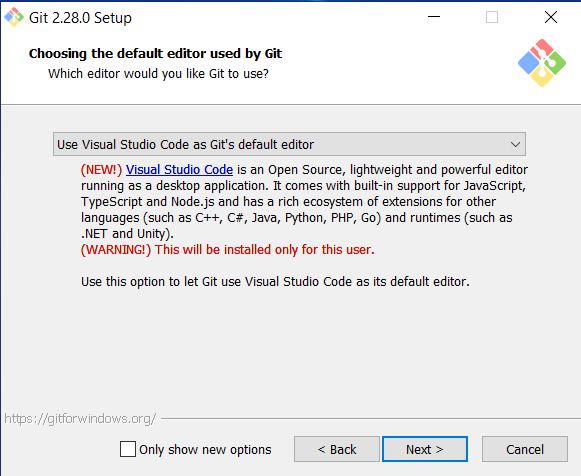
Note if you wish to pin Git Bash to the taskbar, you need to search for the program in the start menu, right click the entry and select “Pin to taskbar”. If you instead first launch the program and pin it by right clicking on the taskbar icon, Git Bash will open with the wrong home directory (
/instead of/c/users/$USERNAME.
After installation, test if you were successful by opening the Git Bash program. Below is a picture of the Git Bash icon on the Desktop and an opened instance of the Git Bash terminal (we will often refer to this as just “the terminal”):
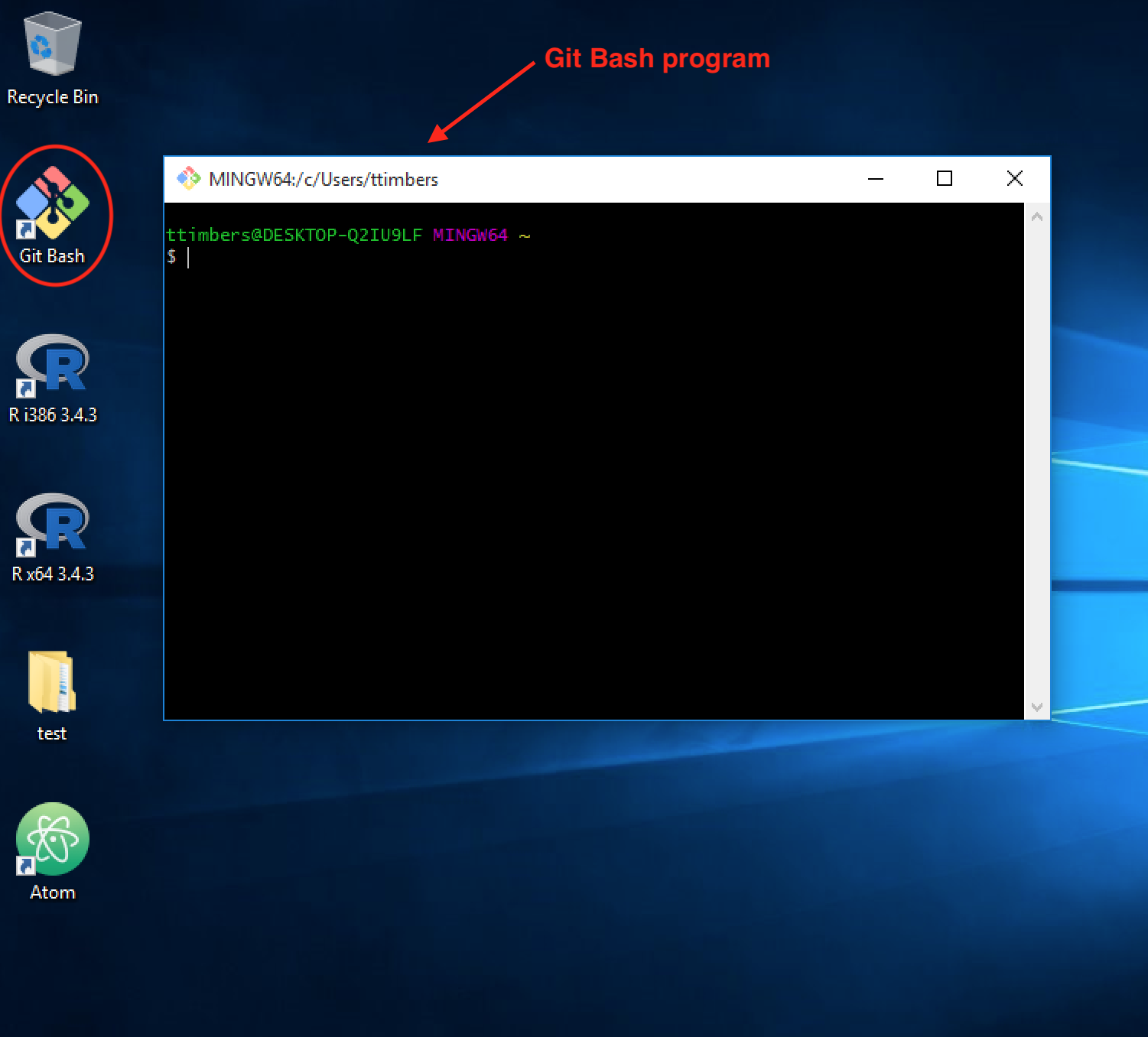
In the terminal, type the following to check which version of Bash you just installed:
bash --version
The output should look similar to this:
GNU bash, version 4.4.23(1)-release (x86_64-pc-sys)
Copyright (C) 2019 Free Software Foundation, Inc.
License GPLv3+: GNU GPL version 3 or later <http://gnu.org/licenses/gpl.html>
This is free software; you are free to change and redistribute it.
There is NO WARRANTY, to the extent permitted by law.
If you tried to paste the above into the Git Bash terminal, you will have noticed that
Ctrl+Vdoes not work in Git Bash. Instead you need to right click and select “Paste” or use theShift+Insertshortcut. To copy from the Git Bash terminal you simply select the text you want and it is copied automatically.
Via right click you can also reach the settings menu where you can configure Git Bash to your preferences, a couple of tips would be to check “Mouse -> Clicks place command line cursor” and change the font to something more legible, e.g. Consolas (“Text -> Select”).
Let’s also check which version of git was installed:
git --version
git version 2.28.0.windows.1
You can launch many windows programs from the Bash terminal, e.g. to launch VS Code that we installed previously, you would type in code, let’s use this to check the version of vscode that we installed:
code --version
1.47.3
91899dcef7b8110878ea59626991a18c8a6a1b3e
x64
Configuring Git user info¶
Next, we need to configure Git by telling it your name and email. To do this type the following into the terminal (replacing Jane Doe and janedoe@example.com, with your name and email (the same used to sign up for GitHub), respectively):
git config --global user.name "Jane Doe"
git config --global user.email janedoe@example.com
Note: to ensure that you haven’t made a typo in any of the above, you can view your global Git configurations by either opening the configuration file in a text editor (e.g. via the command
code ~/.gitconfig) or by typinggit config --list --global.
Setting VS Code as the default editor¶
To make programs run from the terminal (such as git) use VS Code by default, we will modify ~/.bash_profile. First, open it using VS Code:
code ~/.bash_profile
Note: If you see any existing lines in your
~/.bash_profilerelated to a previous Python or R installation, please remove these.
Append the following lines:
# Set the default editor for programs launch from terminal
EDITOR="code --wait"
VISUAL=$EDITOR # Use the same value as for "EDITOR" in the line above
Then save the file and exit VS Code.
Most terminal programs will read the
EDITORenvironmental variable when determining which editor to use, but some readVISUAL, so we’re setting both to the same value.
Python, Conda, and JupyterLab¶
Python and Conda¶
We will be using Python for a large part of the program, and conda as our Python package manager. To install Python and the conda package manager, we will use the Miniconda platform (read more here), for which the Python 3.8 64-bit version can be downloaded here. After the download has finished, run the installer and accept the default configuration for all pages.
Do not add miniconda to PATH. We will set this up later.
After installation, open the Start Menu and search for the program called “Anaconda Prompt (miniconda3)”. When this opens you will see a prompt similar to (base) C:\Users\your_name. Type the following to check that your Python installation is working:
python --version
which should return something like this:
Python 3.8.3
If instead you see
Python 2.7.Xyou installed the wrong version. Follow these instructions to delete this installation and try the installation again, selecting Python 3.8.
Integrating Python with the Git Bash terminal¶
To avoid having to open the separate Anaconda Prompt every time we want to use Python, we can make it available from the (Git Bash) terminal, which is what we will be using most of the time. To set this up, open the “Anaconda Prompt (miniconda3)” again and type:
conda init bash
You will see that this modified a few configuration files, which makes conda visible to the terminal. Close all open terminal windows and launch a new one, you should now see that the prompt string has changed to include the word (base) as in the screenshot below:
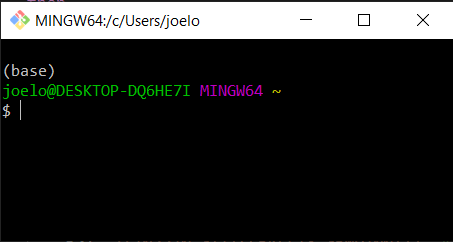
If you type
python --version
you should now see the same output as above:
Python 3.8.3
Note that if you want to run Python interactively from the Git Bash terminal, you need to prepend the
winptycommand, so the full command would bewinpty python(if you run this, note that you can exit the Python prompt by typingexit()). Running justpythonworks on other setups, but will freeze the Git Bash terminal.
Let’s also check the version of the conda package manager. If you type
conda --version
you should see something like this
conda 4.8.3
Optional One annoyance with our current terminal setup is that the word
(base)is not on the same row as the rest of the prompt string (the part withyour_name@your_computer. To fix this we can edit the.bash_profileconfiguration file to indicate that we do not want a newline at the beginning of the prompt string. Open up the configuration file using VS Code by typing the following command into a terminal:code "/c/Program Files/Git/etc/profile.d/git-prompt.sh"Delete the line that reads the following (it should be line 13):
PS1="$PS1"'\n' # new lineClick to save the file, when VS Code prompts you that the saving failed, click “Retry as Admin” and then “Yes”. That’s it! Now if you launch a new terminal instance, you will see
(base)on the same line as the rest of the prompt string as in the screenshot below.
Essential Python packages¶
conda installs Python packages from different online repositories which are called “channels”.
A package needs to go through thorough testing before it is included in the default channel,
which is good for stability,
but also means that new versions will be delayed and fewer packages are available overall.
There is a community-driven effort called the conda-forge (read more here),
which provides more up to date packages
To enable us to access the most up to date version of the Python packages we are going to use,
we will add the more up to date channel,
To add the conda-forge channel by typing the following in the terminal:
conda config --add channels conda-forge
To install packages individually, we can now use the following command: conda install <package-name>. Let’s install the key packages needed for the start of the MDS program:
conda install \
jupyterlab=2.* \
numpy=1.* \
pandas=1.* \
flake8=3.* \
black=19.*
conda will show you the packages that will be downloaded,
and you can press enter to proceed with the installation.
If you want to answer yes by default and skip this confirmation step,
you can replace conda install with conda install -y.
Next we will update nbconvert (which was installed with jupyterlab),
because we require a more recent version to make it work well with tinytex on Windows,
which we will install later.
To install the latest version directly from GitHub,
we need to use the pip package manager instead of conda:
pip install https://github.com/jupyter/nbconvert/archive/6.0.0a6.zip
Note: we will use many more packages than those listed above across the MDS program, however we will manage these using virtual environments (which you will learn about in DSCI 521: Platforms for Data Science).
JupyterLab setup¶
We will be using the Jupytext Python package and the JupyterLab git extension to facilitate using Jupyter notebooks with Git & GitHub. Install them via the following commands:
conda install -y nodejs=10.*
pip install --upgrade jupyterlab-git
conda install -y jupytext=1.*
jupyter lab build
To test that your JupyterLab installation is functional, you can type jupyter lab into a terminal, which should open a new tab in your default browser with the JupyterLab interface.
To exit out of JupyterLab you can click File -> Shutdown,
or go to the terminal from which you launched JupyterLab and hold Ctrl while pressing c twice.
R, IRkernel, Rtools, and RStudio¶
R is another programming language that we will be using a lot in the MDS program. We will use R both in Jupyter notebooks and in RStudio.
R¶
Go to https://cran.r-project.org/bin/windows/base/ and download the latest version of R for Windows (4.0.2 at the time of writing). Open the file and follow the installer instructions accepting the default configuration.
After the installation is complete, we will add the R executables to the PATH variable in terminal so that you can use it without typing the full path to R each time. Open a terminal and type:
code ~/.bash_profile
Append the following line to the file
# Add R and Rscript to PATH
export PATH="/c/Program Files/R/R-4.0.2/bin/x64":$PATH
Then save the file and exit VS Code. Now you can open terminal and type
R --version
which should return something like:
R version 4.0.2 (2020-06-22) -- "Taking Off Again"
Copyright (C) 2020 The R Foundation for Statistical Computing
Platform: x86_64-w64-mingw32/x64 (64-bit)
R is free software and comes with ABSOLUTELY NO WARRANTY.
You are welcome to redistribute it under the terms of the
GNU General Public License versions 2 or 3.
For more information about these matters see
https://www.gnu.org/licenses/.
Note: Although it is possible to install R through Anaconda, we highly recommend not doing so. In case you have already installed R using Anaconda you can remove it by executing
conda uninstall r-base.
RStudio¶
Download the Windows version of RStudio from https://www.rstudio.com/products/rstudio/download/preview. Open the file and follow the installer instructions.
To see if you were successful, try opening RStudio by clicking on its icon. It should open and looks something like this picture below:

Next, we will make sure that Rstudio uses the same directories as R from terminal for its configuration. To do this, we will need to set an environmental variable in Windows. First, open the start menu, type “env” and select the match that reads “Edit the system environment variables”. Click the button at the bottom that reads “Environmental Variables…”:
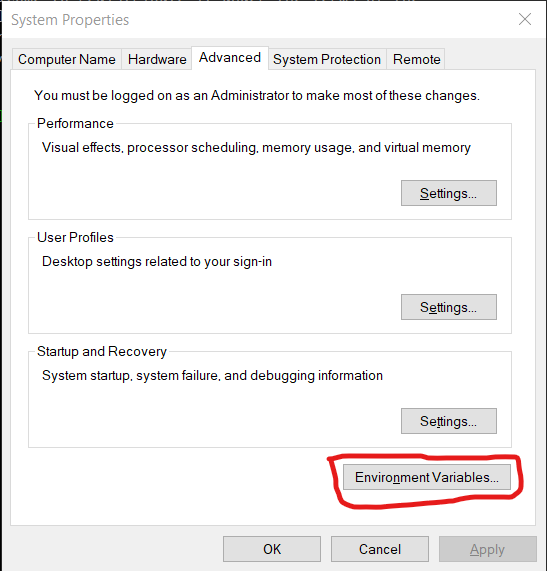
Under “User variable” click the “New…” button:

And type in R_USER as the “Variable name” and C:\Users\username as the “Variable value”, replacing username with your actual user name (if you don’t know your user name, look at the top of the screenshot above where it says “User variables for your_username”):

Click “OK” on all of the three windows we opened above and you’re done! If you open RStudio and R from terminal and type
.libPaths()
both should return the same values, e.g.
"C:/Users/joelo/R/win-library/4.0" "C:/Program Files/R/R-4.0.2/library"
Rtools¶
Windows users will also need to install Rtools, which will allow you to use external libraries. Go to http://cran.r-project.org/bin/windows/Rtools/ and download the latest version (e.g., Rtools40.exe). After the download has finished, run the installer with the default configuration. Do not follow the Rtools’ website instructions for “Putting Rtools on the PATH”. RStudio will put Rtools on the PATH automatically when it is needed.
To test if you’re installation was successful, open RStudio and type the following into the Console:
install.packages("jsonlite", type = "source")
If the jsonlite package installs without errors, Rtools is setup correctly.
Essential R packages¶
Next, install the key R packages needed for the start of MDS program, by opening up RStudio and typing the following into the R console inside RStudio:
install.packages(c('tidyverse', 'blogdown', 'xaringan', 'renv', 'devtools', 'usethis'))
If you get a prompt asking if you want to install packages that need compilation from sources, click “Yes”.
Note: we will use many more packages than those listed above across the MDS program, however we will manage these using the
renvpackage manager (which you will learn about in DSCI 521: Platforms for Data Science).
IRkernel¶
The IRkernel package is needed to make R work in Jupyter notebooks. To enable this kernel in the notebooks, open R from a terminal and run the setup via the following two commands:
install.packages('IRkernel')
IRkernel::installspec()
When asked to select a mirror, pick one at a location close to where you live for faster downloads.
Note that you cannot use RStudio for this step because it will not be able to find the jupyter installation. R from terminal will since the correct PATH for jupyter is set when the terminal is launched.
To see if you were successful, try running JupyterLab and check if you have a working R kernel. To launch the JupyterLab type the following in the terminal:
jupyter lab
A browser should have launched and you should see a page that looks like the screenshot below. Now click on “R” notebook (circled in red on the screenshot below) to launch an JupyterLab with an R kernel.
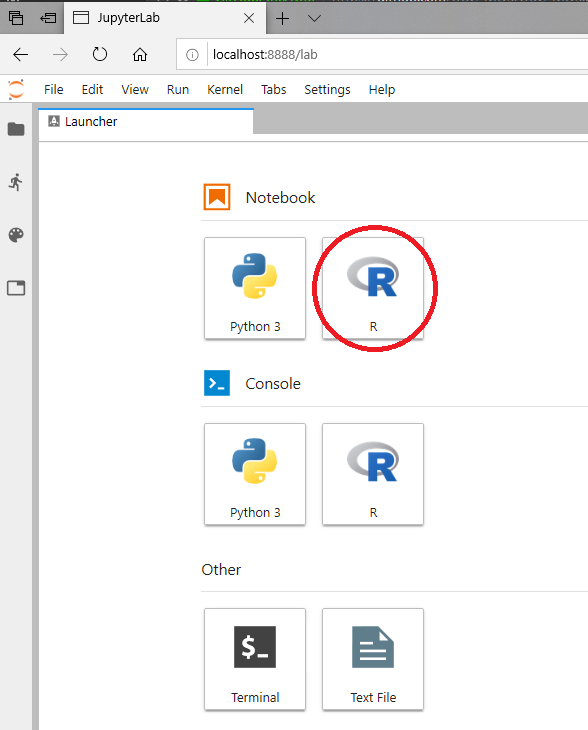
Sometimes a kernel loads, but doesn’t work as expected. To test whether your installation was done correctly now type library(tidyverse) in the code cell and click on the run button to run the cell. If your R kernel works you should see something like the image below:
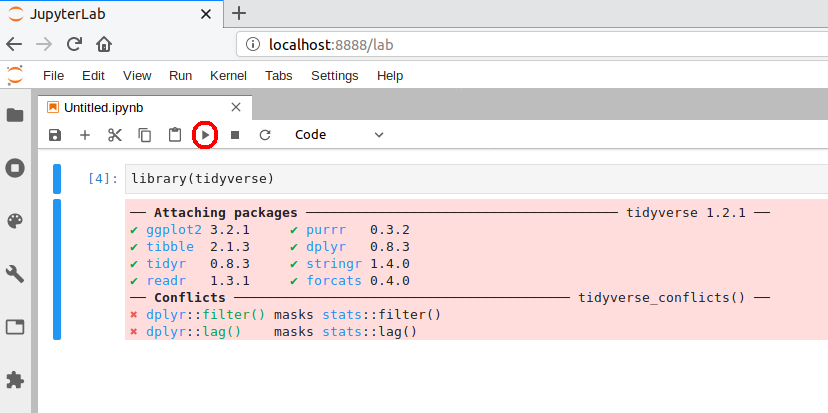
To improve the experience of using R in JupyterLab,
we will add an extension that allows us to setup keyboard shortcuts for inserting text
(thanks to former MDS student Ryan Homer for developing this extension!).
By default,
it creates shortcuts for inserting two of the most common R operators: <- and %>%.
Run the following from terminal to install the extension:
jupyter labextension install @techrah/text-shortcuts
jupyter lab build
To check that the extension is working,
open JupyterLab,
launch an R notebook,
and try inserting the operators by pressing Alt + - or Shift + Ctrl + m, respectively.
LaTeX¶
We will install the lightest possible version of LaTeX and it’s necessary packages as possible so that we can render Jupyter notebooks and R Markdown documents to html and PDF. If you have previously installed LaTeX, please uninstall it before proceeding with these instructions.
First, open RStudio and run the following commands to install the tinytex package and setup tinytex:
install.packages('tinytex')
tinytex::install_tinytex()
Note that you might see two error messages regarding lua during the installation, you can safely ignore these, the installation will complete successfully after clicking “OK”.
You can check that the installation is working by opening a terminal and asking for the version of latex:
latex --version
You should see something like this if you were successful:
pdfTeX 3.14159265-2.6-1.40.21 (TeX Live 2020)
kpathsea version 6.3.2
Copyright 2020 Han The Thanh (pdfTeX) et al.
There is NO warranty. Redistribution of this software is
covered by the terms of both the pdfTeX copyright and
the Lesser GNU General Public License.
For more information about these matters, see the file
named COPYING and the pdfTeX source.
Primary author of pdfTeX: Han The Thanh (pdfTeX) et al.
Compiled with libpng 1.6.37; using libpng 1.6.37
Compiled with zlib 1.2.11; using zlib 1.2.11
Compiled with xpdf version 4.02
The above is all we need to have LaTeX work with R Markdown documents, however for Jupyter we need to add several more packages. Before we do this, please sign out of Windows and back in again in order for the Git Bash terminal to be able to find the location of TinyTex.
When you sign back in, install the additional LaTeX packages needed for Jupyter by pasting the following into the new terminal instance and press enter: by pasting the following:
tlmgr.bat install eurosym \
adjustbox \
caption \
collectbox \
enumitem \
environ \
fp \
jknapltx \
ms \
parskip \
pgf \
rsfs \
tcolorbox \
titling \
trimspaces \
ucs \
ulem \
upquote
To test that your latex installation is working with jupyter notebooks,
launch jupyter lab from a terminal and open either a new notebook
or the same one you used to test IRkernel above.
Go to File -> Export notebook as... -> Export Notebook to PDF.
If the PDF file is created,
your LaTeX environment is set up correctly.
Make¶
Later in the program, we will be using make to automate our analysis scripts. Download make from this URL. Click on the downloaded zip-file to open it in the File Explorer and click the button in the “Extract” tab that reads “Extract all”. Change the extract location to C:\Users\YOUR_USERNAME\make-4.3 (substituting in your actual username instead of YOUR_USERNAME) and click “Extract”. See the screenshots below if you’re unsure what to click.
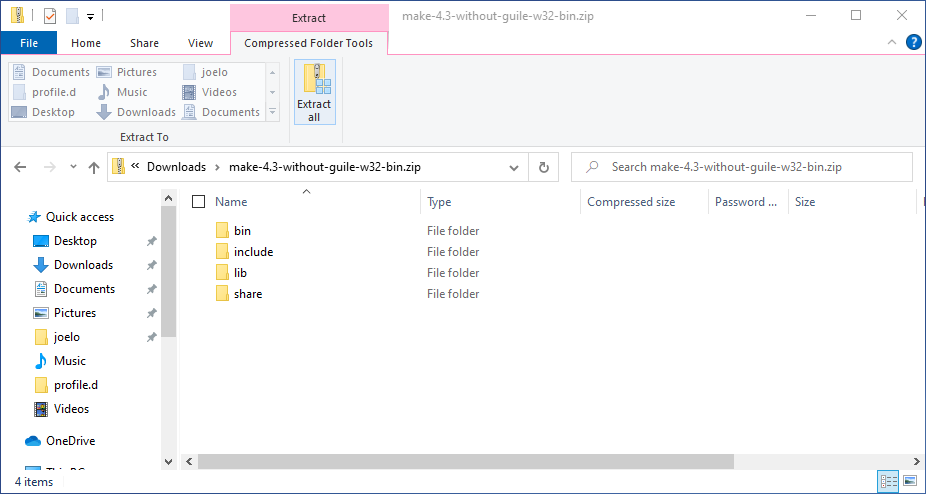

Next we need to add make’s bin folder to our PATH so that we can use the command make from the terminal (like we did with R earlier). Open the bash configuration file with VS Code again by pasting this into a terminal:
code ~/.bash_profile
And replace the section that reads:
# Add R and Rscript to path
export PATH="/c/Program Files/R/R-4.0.2/bin/x64":$PATH
with the following to prepend make’s bin folder to the PATH
(note that ${USERNAME} below will be automatically expanded to your actual username by bash,
so you don’t need to replace it manually.
# Add R, Rscript, and Make to path
export PATH="/c/Users/${USERNAME}/make-4.3/bin":"/c/Program Files/R/R-4.0.2/bin/x64":$PATH
Then save the file and exit VS Code. Launch a new terminal and run
make --version
which should return something like
GNU Make 4.3
Built for Windows32
Copyright (C) 1988-2020 Free Software Foundation, Inc.
License GPLv3+: GNU GPL version 3 or later <http://gnu.org/licenses/gpl.html>
This is free software: you are free to change and redistribute it.
There is NO WARRANTY, to the extent permitted by law.
PostgreSQL¶
We will be using PostgreSQL as our database management system. You can download PostgreSQL 12.4 from here (do not select version 13). Follow the instructions for the installation. In the password page, type whatever password you want, but make sure you’ll remember it later. For all the other options, use the default. You do not need to run “StackBuilder” at the end of the installation (if you accidentally launch the StackBuilder, click “cancel”, you don’t need to check any boxes).
To test if the installation was successful open the SQL Shell app from the Start menu. You will be asked to setup your configuration, accept the default value (the one within square brackets) for the first four values by pressing enter four times, then type in your password and press enter one last time. It should look like this if it is working correctly:

Docker¶
You will use Docker to create reproducible, sharable and shippable computing environments for your analyses. For this you will need a Docker account. You can sign up for a free one here.
After signing-up and signing into the Docker Store, go here and click on the “Get Stable” button on the right hand side of the screen. Then follow the installation instructions on that screen to install the stable version.
After installation (Docker will make you sign out to finish installing), launch a terminal and type
docker run hello-world
which should output something like this:
Unable to find image 'hello-world:latest' locally
latest: Pulling from library/hello-world
0e03bdcc26d7: Pulling fs layer
0e03bdcc26d7: Verifying Checksum
0e03bdcc26d7: Download complete
0e03bdcc26d7: Pull complete
Digest: sha256:49a1c8800c94df04e9658809b006fd8a686cab8028d33cfba2cc049724254202
Status: Downloaded newer image for hello-world:latest
Hello from Docker!
This message shows that your installation appears to be working correctly.
To generate this message, Docker took the following steps:
1. The Docker client contacted the Docker daemon.
2. The Docker daemon pulled the "hello-world" image from the Docker Hub.
(amd64)
3. The Docker daemon created a new container from that image which runs the
executable that produces the output you are currently reading.
4. The Docker daemon streamed that output to the Docker client, which sent it
to your terminal.
To try something more ambitious, you can run an Ubuntu container with:
$ docker run -it ubuntu bash
Share images, automate workflows, and more with a free Docker ID:
https://hub.docker.com/
For more examples and ideas, visit:
https://docs.docker.com/get-started/
VS Code extensions¶
The real magic of VS Code is in the extensions that let you add languages, debuggers, and tools to your installation to support your specific workflow. From within VS Code you can open up the Extension Marketplace to browse and install extensions by clicking on the Extensions icon in the Activity Bar indicated in the figure below.

To install an extension, you simply search for it in the search bar, click the extension you want, and then click “Install”. There are extensions available to make almost any workflow or task you are interested in more efficient! Here we are interested in setting up VS Code as a Python IDE. To do this, search for and install the following extensions:
Python (everything Python: notebooks, debugging, linting, formatting, etc.)
markdownlint (markdown linting and style checking extension)
GitLens (powerful extension that extends VS Code’s native git capabilities)
Docker (easily use Docker from VS Code)
(Optional) Material Theme and/or Predawn Theme Kit (additional colour themes to choose from)
(Optional) Material Icon Theme (great-looking custom file icons!)
(Optional) Bracket Pair Colorizer 2 (add colour to help distinguish your brackets: (), [], {})
This video tutorial is an excellent introduction to using VS Code in Python.
Improving the bash configuration¶
To improve your experience using bash, we recommend appending a few lines to the end of your bash configuration file. This is optional, but makes it easier to use the TAB key for autocompletion and improves how bash handles the command history (we will talk more about these topics during class). First, open the configuration file:
code ~/.bash_profile
Then paste the following at the end of the file (make sure not to overwrite any existing lines) and save it afterwards:
# TAB completion configuration
# TAB completion ignores case
bind "set completion-ignore-case on"
# Require only one instead of two TAB presses before showing matches
bind "set show-all-if-ambiguous on"
# If there are multiple matches for completion, cycle through them with TAB
bind 'TAB':menu-complete
# Perform partial completion on the first Tab press,
# only start cycling full results on the second Tab press
bind "set menu-complete-display-prefix on"
# History configuration
# Cycle through history based on characters already typed on the line
bind '"\e[A":history-search-backward'
bind '"\e[B":history-search-forward'
# Append to the history file, don't overwrite it.
shopt -s histappend
# Write commands to history one-by-one right after they are executed
# instead of all together when the terminal is closed.
# Make new terminals see all commands run in currently open terminals and
# prepend a newline to the prompt string to separate it from the last command's output
PROMPT_COMMAND='history -a; echo'
# Increase history size
HISTSIZE=50000
HISTFILESIZE=50000
# Aliases
# Note that aliases only are in effect when you are using the shell interactively
# (e.g. opening the Git Bash terminal and typing or pasting commands).
# If you run a bash script or makefile,
# the original command is used instead of your alias.
# Run Python and Docker in compatibility mode when started from an interactive shell
alias python="winpty python"
alias docker="winpty docker"
# `man` function to display help messages with a pager as on Unix
man() {
$1 --help | less
}
Post-installation notes¶
You have completed the installation instructions, well done 🙌! We have created a script to help you check that your installation was successful, and to provide instructions for how you can troubleshoot any potential issues. To run this script, please execute the following command from your terminal.
bash <(curl -Ss https://raw.githubusercontent.com/UBC-MDS/UBC-MDS.github.io/master/resources_pages/check-setup-mds.sh)
The output from running the script will look something like this:
# MDS setup check 0.1.0
If a program or package is marked as MISSING,
this means that you are missing the required version of that program or package.
Either it is not installed at all or the wrong version is installed.
The required version is indicated with a number and an asterisk (*),
e.g. 4.* means that all versions starting with 4 are accepted (4.0.1, 4.2.5, etc).
You can run the following commands to find out which version
of a program or package is installed (if any):
```
name_of_program --version # For system programs
conda list # For Python packages
R -q -e "installed.packages()[,c(Package, Version)]" # For R packages
```
Checking program and package versions...
## Operating system
Microsoft Windows 10 Education
64-bit
10.0.19041
## System programs
OK psql 12.3
MISSING rstudio=1.*
OK R 4.0.2 (2020-06-22) -- "Taking Off Again"
OK python 3.8.3
OK conda 4.8.3
OK bash 4-pc-linux-gnu)
OK git 2.27.0
OK make 4.3
OK latex 3.14159265-2.6-1.40.21 (TeX Live 2020)
OK tlmgr 55369 (2020-06-01 02:32:00 +0200)
MISSING docker=19.*
MISSING code=1.*
## Python packages
MISSING jupyterlab=2.*
MISSING numpy=1.*
MISSING pandas=1.*
OK flake8=3.7.9
MISSING black=19.*
MISSING nodejs=10.*
OK jupytext=1.3.4
MISSING jupyterlab-git=0.*
MISSING jupyterlab PDF-generation failed. Check that latex and jupyterlab are marked OK above.
## R packages
OK tidyverse=1.3.0
OK blogdown=0.20
OK xaringan=0.16
OK renv=0.11.0
OK IRkernel=1.1.1
OK tinytex=0.25
OK rmarkdown PDF-generation was successful
This output and additional configuration details
have been saved to the file check-setup-mds.log in this directory.
As you can see at the end of the output, a log file is saved in your current directory. We might ask you to upload this file if we need to troubleshoot your installation, so that we can help you more effectively. If any of your packages are marked as “MISSING” you will need to figure out what is wrong and possibly reinstall them. Once all packages are marked as “OK” we will ask you to submit this log file, so that we can confirm that your installation was successful. Details on where to submit will be provided later.
Note that in general you should be careful running scripts unless they come from a trusted source as in this case (just like how you should be careful when downloading and installing programs on your computer).
